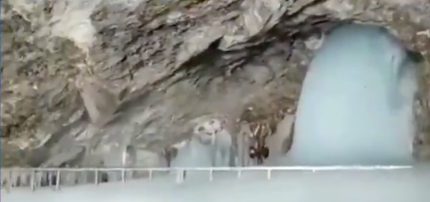SRINAGAR, May 6, 2025 — The unveiling of Baba Barfani, the sacred ice Shivling in the Amarnath Cave Temple, has sparked spiritual excitement across India, even as Jammu & Kashmir grapples with a looming tourism downturn. The Shri Amarnathji Shrine Board revealed stunning visuals of the naturally formed Shivling, standing at an impressive 7 feet, ahead of the Amarnath Yatra, set to begin on July 3 and conclude on August 9, 2025. However, rising tensions along the Line of Control threaten the region’s tourism, a vital economic lifeline, casting a shadow over the pilgrimage season.
The Amarnath Yatra, a revered Hindu pilgrimage, draws lakhs of devotees to the cave at 3,888 meters in Anantnag district, where Lord Shiva is believed to have shared the secret of immortality. This year’s 38-day pilgrimage, ending on Raksha Bandhan, has seen over 3.5 lakh registrations, bolstered by enhanced facilities like RFID tracking, e-KYC verification, and digital payment systems for porters and ponies. Chief Secretary Atal Dulloo, IAS, recently reviewed preparations, ensuring robust security and infrastructure, including medical camps and telecom connectivity, as confirmed during the SASB’s 48th meeting.
Despite these efforts, Kashmir’s tourism sector faces a “long lull” following a deadly attack that triggered mass cancellations. Srinagar’s Dal Lake, typically bustling with Shikara rides, has seen a sharp decline in visitors, with houseboat operators like Yaseen Tuman reporting empty bookings. “Tourism is our backbone, but fear is keeping people away,” Tuman lamented. Posts on X reflect similar concerns, with users warning that the region’s economy, reliant on 3 million annual visitors, could suffer for years. Yet, voices like Faizan Ansari, a recent tourist, urge travelers to visit, praising the “cooperative and well-qualified” locals and the region’s serene beauty.
The Directorate of Information & Public Relations is countering misinformation through Info Connect, a monthly magazine launched by Dulloo to highlight J&K’s development and promote transparency. The publication showcases attractions like Dal Lake and the Amarnath Yatra, aiming to rebuild tourist confidence.
As devotees prepare for the arduous trek via Pahalgam or Baltal routes, the Amarnath Yatra stands as a beacon of faith amidst uncertainty. The Chhari Mubarak procession will mark its closure, reinforcing spiritual unity. However, with war cries echoing across the LoC, Kashmir’s tourism industry—houseboat owners, artisans, and guides—faces an uphill battle. The region’s future hinges on restoring peace and trust, ensuring that the divine call of Baba Barfani and the allure of Dal Lake continue to draw the world to its embrace.




